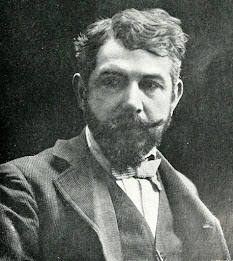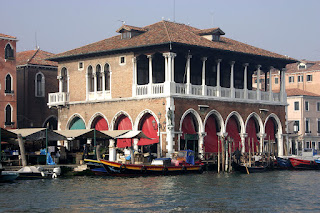NEW - Ettore Tito - painter
Artist who captured life in Venice
The painter Ettore Tito, whose landscapes and scenes from contemporary life in Venice earned him a substantial following in the late 19th and early 20th centuries, was born on this day in 1859 in Castellammare di Stabia, near Naples. Despite his southern roots, Tito spent most of his life in Venice. His Campanian father captained merchant ships but his mother was Venetian and they moved to Venice when Ettore was still a child. His prodigious talent for art emerged at an early age. He was taken under the wing of the Dutch artist Cecil van Haanen and was accepted by the Accademia di Belle Arti at the age of 12, graduating at 17 after studying under Pompeo Marino Molmenti, a distinguished professor. Tito appreciated the beauty of Venice but wanted his paintings to capture the character of the city and its people. He earned the first important recognition of the quality of his work when his 1887 painting Pescheria vecchia a Venezia, a busy scene of traders and customers at the fish market by the Rialto bridge, won great praise at the Esposizione Nazionale Artistica in Venice and was subsequently bought by the Galleria Nazionale d'Arte Moderna in Rome. Read more…
_________________________________________________________
Pope Paul III excommunicates Henry VIII
The day a pontiff finally lost patience with the Tudor king
Pope Paul III announced the excommunication of King Henry VIII of England from the Catholic Church on this day in 1538 in Rome. Henry had been threatened with excommunication by the previous pope, Clement VII, in 1533 after he married Anne Boleyn. However, Clement did not act on his threat straight away, hoping Henry might come to his senses. Henry had been awarded the title of Defender of the Faith by a previous pope because he had written a defence of the seven sacraments of the Catholic church against the protestant leader Martin Luther. But Clement died the following year and a new pope had to be elected. Pope Paul III, who was born Alessandro Farnese, became pontiff in 1534 and took on the job of organising the Counter Reformation as well as using nepotism to advance the power and fortunes of the Farnese family. When it became clear Henry was intent on demolishing the Catholic Church in England, Paul III issued the original papal bull - edict - drawn up by Clement VII. He lost patience with Henry after he declared himself head of the Church of England and started ordering the execution of anyone who stood in his way. Read more…
__________________________________________________________
NATO boss seized by Red Brigades
Brigadier-General James L Dozier held for 42 days
Three years after the kidnap and murder of the former Italian prime minister Aldo Moro shocked Italy and the wider world, terrorists representing the ultra-left group Brigate rosse - the Red Brigades - returned to the headlines on this day in 1981 with the abduction of the high-ranking United States Army officer James L Dozier. Brigadier-General Dozier, who was serving in Italy as deputy Chief of Staff of NATO's Southern European land forces, was seized and taken from his apartment in Verona and held for 42 days before being rescued by Italian special forces. The kidnap took place at between 5.30 and 6pm when four men turned up at the door of the apartment posing as plumbers. The general was overpowered and then struck over the head before his wife, Judith, who was initially held at gunpoint, was tied up with chains and plastic tape. According to his wife, 50-year-old General Dozier was then bundled into what she described as a "steamship trunk", which the men carried out to a waiting van. Mrs Dozier was left in the apartment, alerting neighbours later by banging on the walls. It was the first time the Red Brigades had held a member of the American military, or any foreign national. Read more…
___________________________________________________________
Domenico Cimarosa – opera composer
Musician who developed the model for ‘comic opera’
A prolific composer of operas, Domenico Cimarosa was born on this day in 1749 in Aversa, between Naples and Caserta in Campania. Cimarosa wrote more than 80 operas during his lifetime, including Il matrimonio segreto (The Secret Marriage), which is considered to be his finest work. Other composers judge it to be among the greatest examples of opera buffa, the Italian term for comic opera and Verdi considered it to be the model for the genre. Cimarosa attended a free school connected to a monastery in Naples where the organist taught him music and as a result obtained a scholarship to attend a musical institute in the city for 11 years. He wrote his first opera at the age of 23 and, after several successes in theatres in Naples, he was invited to Rome where he produced another comic opera, L’Italiano in Londra. He travelled throughout Italy, writing operas for theatres in Naples, Rome and Florence until he was invited to St Petersburg by Empress Catherine II. He remained at her court for four years composing music for important occasions. He then went to Vienna at the invitation of Leopold II where he produced his masterpiece, Il matrimonio segreto. Read more…
__________________________________________________________
Leopoldo Eleuteri - flying ace
World War I pilot claimed eight aerial victories
First World War pilot Leopoldo Eleuteri, who was credited with seven of the eight combat victories he claimed, was born in Castel Ritaldi, a small town in Umbria about 60km (37 miles) by road southeast of Perugia, on this day in 1894. Eleuteri did not begin flying active combat sorties as a fighter pilot until February 1918 but progressed rapidly with the 70th Squadron of the Corpo Aeronautico Militare, the airborne arm of the Royal Italian Army. He went on to fly more than 150 sorties and between April 1918 and October 1918 claimed eight enemy planes shot down, being eventually credited with seven successes in his own right. Passionate about all forms of mechanised flight since he was a boy, Eleuteri volunteered for aeronautical service as soon as he was old enough. He was a student in a technical school until he was conscripted in 1915. At first, he was assigned to duty in ordnance factories before being sent to join the 3rd Infantry Regiment of the Royal Italian Army. There, he was allowed to begin aviation training. In October 1916, he qualified as a pilot at Gabardini's flying school at Cameri in Piedmont. Read more…
___________________________________________________________
Rome falls to the Ostrogoths
Sacking in 546 left city a shadow of its former self
The Ostrogoths, the Germanic tribe that took over large parts of the Italian peninsula with the collapse of the Western Roman Empire, achieved a symbolic victory on this day in 546 when an army under the leadership of King Totila captured and sacked Rome following a year-long siege of the Eternal City. The event was part of the Gothic War between the Ostrogoths, who had originated on the Black Sea in the area now known as Crimea, and the Byzantine (Eastern) Empire, between 535 and 554. Totila led a fightback by the Ostrogoths after the fall of the Gothic capital at Ravenna in 540 signalled the apparent reconquest of Italy by the Byzantines. He had swept south with his forces and was based at Tivoli, east of Rome, as he plotted how he would recapture the region of Latium. In 545, he laid siege to the city. Bessas, the commander of the imperial garrison charged with protecting the city, was stubborn but cruel to the Roman citizens. Although he had a stock of grain, he would not let it be used to feed the population unless they paid for it, while at the same time refusing requests from citizens to leave the city. Read more…


















